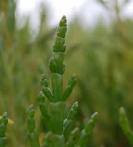Sanicle or Wood Sanicle is also known as Wood March, Self-Heal Sanicle and by other names. It is a member of the Umbelliferae or Apiceae family of plants so is related to carrots, lovage, fennel and dill (among others). It is not related to Self-Heal (Prunella vulgaris), although it is a herb that is reputed to heal wounds just as that is.
Sanicle is native to Europe including the British Isles and to Asia . In Britain
Celui qui sanicle a
De mire affaire il n’a.”
Which loosely translated means that if a person has sanicle, there is no need for a doctor.
Certainly Nicholas Culpeper the 17th century English herbalist believed this as he wrote:-
“It heals green wounds speedily, or any ulcers, imposthumes, or bleedings inward, also tumours in any part of the body; for the decoction or powder in drink taken, and the juice used outwardly, dissipates the humours: and there is not found any herb that can give such present help either to man or beast, when the disease falleth upon the lungs or throat, and to heal up putrid malignant ulcers in the mouth, throat, and privities, by gargling or washing with the decoction of the leaves and roots made in water, and a little honey put thereto. It helps to stay women's courses, and all other fluxes of blood, either by the mouth, urine, or stool, and lasks of the belly; the ulcerations of the kidneys also, and the pains in the bowels, and gonorrhea, being boiled in wine or water, and drank. The same also is no less powerful to help any ruptures or burstings, used both inwardly and outwardly. And briefly, it is as effectual in binding, restraining, consolidating, heating, drying and healing, as comfrey, bugle, self-heal, or any other of the vulnerary herbs whatsoever.”
 This herb has not been subjected to much research, but at the World Congress on Engineering in London in 2010, June 30th – July 2nd, a paper was presented by C.B.Beggs et al which concluded: -
This herb has not been subjected to much research, but at the World Congress on Engineering in London in 2010, June 30th – July 2nd, a paper was presented by C.B.Beggs et al which concluded: - “… the sanicle extract …seemed to promote cell death along the wound margin. These results indicate that sanicle may be used in the care of wounds, but not as a growth promoter, but because it acts as an antibiotic agent, possibly because it aids wound debridement.”
Sanicle is indeed a wound healer according to this research, but does not act in the way that other wound-healing herbs do.
A tisane may be made from 1 ounce of the dried leaves, best gathered in early summer, to purify the blood and to promote internal healing and if taken internally it is said to help clear skin problems. The leaves and tender shoots are edible if cooked, but should be eaten in small amounts as the leaves contain saponins which are toxic. It is believed that the herb taken over a period of time can improve one’s health and help the blood. However pregnant women and breast-feeding mothers should avoid it and it should not be taken if you have stomach problems such as ulcerative colitis or IBS. Large doses can result in vomiting, nausea and stomach upsets. Traditionally it was given for bronchitis and it seems to act as an expectorant.
The decoction of both the roots (harvested in mid-summer and dried) can be applied externally for wounds and skin problems.
More research is needed on this herb if we are to know how it works.






















































